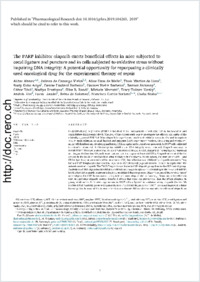The PARP inhibitor olaparib exerts beneficial effects in mice subjected to cecal ligature and puncture and in cells subjected to oxidative stress without impairing DNA integrity: A potential opportunity for repurposing a clinically used oncological drug for the experimental therapy of sepsis
- Ahmad, Akbar Department of Anesthesiology, The University of Texas Medical Branch at Galveston, USA
- Vieira, Juliana de Camargo Laboratório de Investigação Médica, Faculdade de Medicina da Universidade de São Paulo, Brazil
- Mello, Aline Haas de Department of Anesthesiology, The University of Texas Medical Branch at Galveston, USA
- Lima, Thais Martins de Laboratório de Investigação Médica, Faculdade de Medicina da Universidade de São Paulo, Brazil
- Ariga, Suely Kubo Laboratório de Investigação Médica, Faculdade de Medicina da Universidade de São Paulo, Brazil
- Barbeiro, Denise Frediani Laboratório de Investigação Médica, Faculdade de Medicina da Universidade de São Paulo, Brazil
- Barbeiro, Hermes Vieira Laboratório de Investigação Médica, Faculdade de Medicina da Universidade de São Paulo, Brazil
- Szczesny, Bartosz Department of Anesthesiology, The University of Texas Medical Branch at Galveston, USA
- Törö, Gábor Department of Anesthesiology, The University of Texas Medical Branch at Galveston, USA
- Druzhyna, Nadiya Department of Anesthesiology, The University of Texas Medical Branch at Galveston, USA
- Randi, Elisa B. Chair of Pharmacology, Faculty of Science and Medicine, University of Fribourg, Switzerland
- Marcatti, Michela Department of Anesthesiology, The University of Texas Medical Branch at Galveston, USA
- Toliver-Kinsky, Tracy Department of Anesthesiology, The University of Texas Medical Branch at Galveston, USA
- Kiss, András Second Department of Pathology, Semmelweis University Medical School, Budapest, Hungary
- Liaudet, Lucas Department of Intensive Care Medicine and Burns, Lausanne University Hospital Medical Center, Lausanne, Switzerland
- Salomao, Reinaldo Division of Infectious Diseases, Department of Medicine, Hospital São Paulo, Brazil
- Soriano, Francisco Garcia Laboratório de Investigação Médica, Faculdade de Medicina da Universidade de São Paulo, Brazil
- Szabo, Csaba Department of Anesthesiology, The University of Texas Medical Branch at Galveston, USA - Chair of Pharmacology, Faculty of Science and Medicine, University of Fribourg, Switzerland
-
2019
Published in:
- Pharmacological Research. - 2019, vol. 145, p. 104263
English
Poly(ADP-ribose) polymerase (PARP) is involved in the pathogenesis of cell dysfunction, inflammation and organ failure during septic shock. The goal of the current study was to investigate the efficacy and safety of the clinically approved PARP inhibitor olaparib in experimental models of oxidative stress in vitro and in sepsis in vivo. In mice subjected to cecal ligation and puncture (CLP) organ injury markers, circulating and splenic immune cell distributions, circulating mediators, DNA integrity and survival was measured. In U937 cells subjected to oxidative stress, cellular bioenergetics, viability and DNA integrity were measured. Olaparib was used to inhibit PARP. The results show that in adult male mice subjected to CLP, olaparib (1–10 mg/kg i.p.) improved multiorgan dysfunction. Olaparib treatment reduced the degree of bacterial CFUs. Olaparib attenuated the increases in the levels of several circulating mediators in the plasma. In the spleen, the number of CD4+ and CD8+ lymphocytes were reduced in response to CLP; this reduction was inhibited by olaparib treatment. Treg but not Th17 lymphocytes increased in response to CLP; these cell populations were reduced in sepsis when the animals received olaparib. The Th17/Treg ratio was lower in CLP-olaparib group than in the CLP control group. Analysis of miRNA expression identified a multitude of changes in spleen and circulating white blood cell miRNA levels after CLP; olaparib treatment selectively modulated these responses. Olaparib extended the survival rate of mice subjected to CLP. In contrast to males, in female mice olaparib did not have significant protective effects in CLP. In aged mice olaparib exerted beneficial effects that were less pronounced than the effects obtained in young adult males. In in vitro experiments in U937 cells subjected to oxidative stress, olaparib (1–100 μM) inhibited PARP activity, protected against the loss of cell viability, preserved NAD+ levels and improved cellular bioenergetics. In none of the in vivo or in vitro experiments did we observe any adverse effects of olaparib on nuclear or mitochondrial DNA integrity. In conclusion, olaparib improves organ function and extends survival in septic shock. Repurposing and eventual clinical introduction of this clinically approved PARP inhibitor may be warranted for the experimental therapy of septic shock.
- Faculty
- Faculté des sciences et de médecine
- Department
- Médecine 3ème année
- Language
-
- English
- Classification
- Biological sciences
- License
- License undefined
- Identifiers
-
- RERO DOC 326982
- DOI 10.1016/j.phrs.2019.104263
- Persistent URL
- https://folia.unifr.ch/unifr/documents/308158
Statistics
Document views: 65
File downloads:
- sza_pio.pdf: 152
